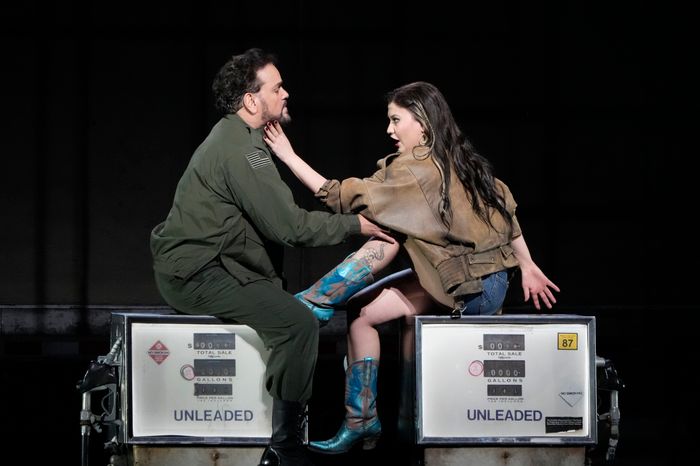
You know from the opening downbeat that the Met’s latest new production is going to be a Carmen on wheels. Conductor Daniele Rustioni tears through the overture like a driver with a radar detector and a taste for risk. Once the curtain goes up, the action takes place at the side of a road. The smugglers in Act Two don’t have a den; they huddle in the empty trailer of a semi, which serves as a truck-stop dance club. After intermission, we see the same truck on its side and in flames. The metaphor applies to the opera’s theme of fate but also the production itself, which starts off shaky and winds up in a ditch. (Or rather on a turntable: The overturned tractor-trailer rotates slowly and repetitively, giving the audience plenty of time to study its undercarriage and roof, for no evident reason.)
The Met’s latest stuck Carmen is directed by Carrie Cracknell, who comes to it with two disadvantages. The first is her stated fear that such a dusty classic will bore the young folks, an attitude I find condescending. Surely Gen-Zers reared on fantasy medieval epics, superheroes, and historical mashups can recognize a badass rebel woman when they see one, even if she happens to live in 19th-century Andalusia. Cracknell’s second struggle is that to overcome this presumptive irrelevance, she moves the action to a setting that opera audiences know even less than they do Spain: America’s industrial heartland. Her Seville is a factory town that’s close to a high mountain pass as well as “the border,” and also has a resident rodeo star. Which is to say, the production explores a geography that, like the America in Saul Steinberg’s New Yorker cover, gets pretty vague west of Tenth Avenue. Michael Levine makes it all duly depressing, and lighting designer Guy Hoare adorns it with LED strips that look like headlights zooming by. This is a landscape where only the luckless pull over and stop. (More mysteriously, for a director intent on updating antiquity, Cracknell and her team also seem to have an approximate acquaintance with the present; for some reason, the production has an early-’90s slacker vibe.)
There’s nothing wrong with modernizing a classic or emphasizing discomforts we’ve grown inured to. Carmen can be bracing as well as seductive. The sparking currents of class and race are timely. Don José is a passive but possessive male who can only assert himself through violence. Carmen deploys her sexuality as a weapon because that’s pretty much all the power she has. These elements, as urgent now as they were at the Paris premiere in 1875, make the opera flexible enough to stimulate a director’s imagination. Yet they’re already embedded in the score, so there’s no real need to invent new sources of what the director describes as “shame, anger, and disempowerment … gendered harassment, and violence against women.” The work’s power is its specificity. Carmen is a complicated person, not an archetype. She works in a cigarette factory, linking a Parisian gentleman’s consumer pleasures with tobacco’s brutal labor conditions. The music’s flavor is Spanish because an Andalusian setting suited Bizet’s need for both clarity and projection; exoticism throws the violence into relief.
In unstitching this quilt of themes, Cracknell winds up making the opera generic: It’s set somewhere, sometime, among unspecified economic conditions. (I doubt the typical U.S. gun factory is a chaotic sweatshop that only employs women in pink smocks — or that the Army provides security.) In attempting to make the story more trenchant, Cracknell has effectively softened it. Take the character of Escamillo, the swaggering toreador who’s been retrained as a rodeador. Instead of killing bulls for a living, he rides them — which would be a clever adaptation, except that the switch makes a hash of the final act’s structure, with its parallel stabbings and tragic blood rite.
These misconceptions would matter little if they framed a musically spectacular performance. In this case, though, the cast seems unsteady, or at least unconvinced. Rafael Davila stepped in for Piotr Beczala on the night I attended, singing an awkward Don José, justifiably anxious about hitting the high notes. Aigul Akhmetshina’s mezzo-soprano has the sultriness and burnished-wood tone for the title role, and Tim Scutt has outfitted her in Daisy Dukes and teal cowboy boots to show off her looks. But she never seems at ease with the role, especially when slinking along a chain-link fence or hoisting herself on top of a gas pump for a little precarious shimmying.
There is one point in the evening when all the little irritants fade away and genuine, liquid opera pours from the stage: Micaëla’s Act Three aria of quaking fortitude, “Je dis que rien ne m’épouvante.” The soprano Angel Blue pauses in the spotlight, turns to the audience, and sings ravishing music with subtlety and power, just as divas have been doing for centuries. It’s a wonderful few minutes — until you realize that the hometown sweetheart with a message from Mom has just upstaged the wild woman of the title. When that happens, it means your Carmen has a problem.
Carmen is at the Metropolitan Opera through May 25.


